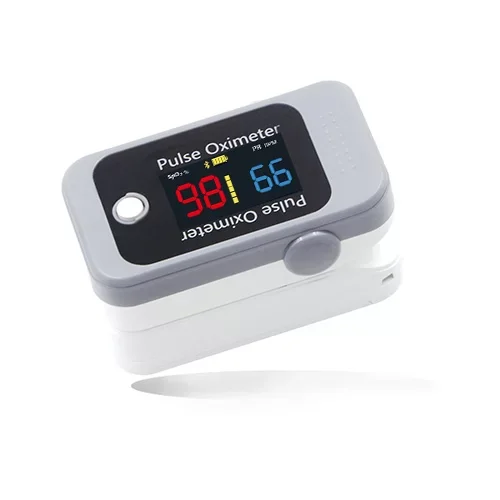Finger pulse oximeter can accurately help patients measure the blood oxygen saturation of the human body, which is of great significance in the field of clinical medicine. Today, Berry is here to talk to you about how to use a portable finger pulse oximeter with Bluetooth and what the normal value of a finger pulse oximeter should be.
How to use a finger pulse oximeter?
When using it for the first time, press the Reset button, and the LCD screen will display the standby state.
Press to open the clip. Put the middle finger of the left or right hand into the working compartment (you can see the infrared light in the working compartment.
After the finger and the working chamber are in full contact, the LCD displays the detection process. (Pay attention to entering the detection state, keep the tested finger stable, do not shake it up and down, left and right).
After 30 seconds, release the clamp, withdraw the finger from the working chamber, and the LCD freezes the test results. The %SpO2 at the top of the screen is the blood oxygen indicator. Min is the pulse rate at the bottom of the screen.
How a finger pulse oximeter works?
The finger pulse oximeter establishes an empirical formula for data processing based on the absorption spectral characteristics of reduced hemoglobin and oxyhemoglobin in the red and near-red light regions using Lambert Beer's law. Using photoelectric blood oxygen detection technology combined with plethysmography technology, two beams of light with different wavelengths (660nm red light and 940nm near-infrared light) are used to illuminate the fingernail tip of the human body through a see-through clip-type sensor, and the measurement signal is obtained by the photosensitive element. After the acquired information is processed by the electronic circuit and the microprocessor, the measured results are displayed by two sets of LEDs.

The dangers of low blood oxygen saturation
1. Low oxygen saturation can cause shortness of breath
Shortness of breath is one of the symptoms of low blood oxygen saturation. It means that this dangerous disease needs to be treated immediately. Shortness of breath can also be caused by various factors such as sullen yang-cold lung disease. Sustained low oxygen saturation can lead to permanent damage where the body cannot breathe.
2. Low oxygen saturation will deprive energy
Oxygen supplies energy to the body and cells. Low oxygen saturation can deprive cells of a source of energy. Fatigue, listlessness, and muscle weakness are hallmark symptoms of a lack of energy. Cells are hypoxic and unresponsive to the entire supply. If you also experience extreme fatigue symptoms, you should consider whether low blood oxygen saturation is the result. You can find out about this with a blood test.
3. Low blood oxygen saturation can cause psychological problems
Brain function depends on oxygen. Brain cells die without oxygen. Low blood oxygen saturation can cause psychological problems such as confusion and short-term memory loss. If it is accompanied by other symptoms of low blood oxygen saturation, such as finger tingling and chronic cough, it should be treated immediately.
4. Low oxygen saturation can cause high altitude pulmonary edema
This happens when traveling at high altitudes. The rarefied air here is low in oxygen, and the body becomes deoxygenated very quickly.
Normal blood oxygen saturation
It is generally recognized that the normal SpO2 should not be less than 94% and below 94% is insufficient oxygen supply. Some scholars set SpO2<90% as the standard for hypoxemia, and believe that when SpO2 is higher than 70%, the accuracy can reach +2%, and when Sp02 is lower than 70%, there may be errors.
Clinically, we have compared the SpO2 value of several patients with the arterial blood oxygen saturation value and believed that the SpO2 reading can reflect the patient's respiratory function and reflect the changes in arterial blood oxygen to a certain extent.
After thoracic surgery, in addition to individual cases where the clinical symptoms do not match the values, gas analysis is required. The routine application of pulse and oxygen saturation monitoring can provide meaningful indicators for clinical observation of changes in the condition, avoid repeated blood collection, and reduce nursing care. Ten's workload is worth promoting.
Generally more than 90% of the clinical can be, of course, to different departments.

Finger Pulse Oximeter Manufacturer - Berry
Berry medical electronic instruments is in the leading level in this industry. In 2009, we have obtained the production license and product registration certificate that issued by Shanghai FDA. And in 2014, Berry passed the EN ISO 13485 quality system certification and CE certification by TÜV SÜD. And we got the FDA 510K in 2015. We are waiting for your consultation!















Comments (0)